Introduction to Embedded Systems
The system in which dedicated purpose of
software is embedded into a hardware design is known as embedded
system. This system may be either an independent system or a larger
system. The software usually gets embedded into memory modules as ROM, and it does not need any secondary memory as in a computer. Telecom, smart cards, missiles, computer networking, digital consumer electronics and satellites are some of the embedded systems applications.
Embedded systems applications
include Robotics, digital camera, multi-tasking toys, cooking and
washing systems, biomedical systems, key-board controllers, mobile &
smart phones, computing systems, electronic smart weight display system
and entertainment systems, such as videos, games, music system and
video games, and so on.
Embedded system design process
can be done by simulation first, which is used for testing the circuit
because changing hardware becomes very difficult if the circuit
malfunctions. If the results are matched with the desired ones, the
process will be designed permanently by sequential wafer processes.
Basics of Embedded Systems
Embedded systems are designed to perform
specific tasks, but cannot be used as general purpose computers to
perform different tasks. The software for embedded system is normally
referred to as firmware, which can be stored in a disc or in a single
chip. The two main elements of the systems are:
- Embedded System Hardware
- Embedded System Software
Embedded System Hardware:
An embedded system requires a hardware platform to interact with
various real-time inputs and outputs or variables. The hardware includes
controller like microcontroller or microprocessor, memory modules, I/O interfaces, display systems and communication modules, etc.
Embedded System Software:
This software allows programming in a desired fashion such that it
controls various operations. It is written in a high-level format,
compiled into code, and then dumped into hardware controllers.
Real-time embedded systems
are computer systems that perform the actions, such as monitoring,
responding and controlling external movement. The external environment
is connected to the computer system through sensors,
actuators and I/O interfaces. A real computer system embedded with a
computer system is known as real-time embedded system. A real-time
embedded system is used in different fields such as military, government
sectors and in medical.
Robotic Real Time Projects in Embedded Systems
Embedded systems can be used in many of the real-time applications such as automobiles, robotics, industries, etc. The following real-time projects are related to robotics technology.
1. Voice Controlled Robotic Vehicle with Long Distance Speech Recognition
The aim of this project is to control a robotic vehicle by voice commands for remote operation. An 8051 microcontroller
is used with a speech recognition module to perform the desired
operation. It uses an 8051 micro controller, a speech recognition
module, a push button, an RF module, an encoder, a decoder, a
motor-driver IC, DC motors, batteries and other miscellaneous
components.
Vehicle movements like left, right, up
and down can be performed by using push buttons or voice commands by a
speech-recognition module which is interfaced with the microcontroller.
Here, an encoder is used to encode the commands given to the
microcontroller by using the RF transmitter to transmit the signals at the frequency of 433 MHz.
Therefore, when signals that emerge by
pressing buttons, or the voice command signals corresponding to the
movement are received by the micrcontroller, it sends control signals to
the reciever circuit through the transmitter module.
Upon receiving these signals, An RF
reciever transfers those signals to a decoder circuit wherein the binary
data is converted into a micrcontroller-level signal. Therefore, the
micrcontroller performs the desired movement from the transmitter
circuit. Laser module is interfaced with the microcontroller for detecting the operations performed by the robot even in dark places.
2. Touch screen-based Remote Controlled Robotic Vehicle for Store Management
This project involves controlling a robotic vehicle using a touch-screen display unit for remote operation. A touch-screen panel is placed at the transmitter end, and a pick-n-place robot
is placed at the receiver end to perform a task by responding to the
signals. The hardware components used in this project include an 8051
microcontroller, a touch-screen panel, antennas (transmitter- receiver
side), an encoder, a decoder, DC motors, a Robotic body, a battery, etc.
As discussed in the speech recognition
module of the above project, in this project also a touch screen module
sends the control signals corresponding to the vehicle movement to the
microcontroller. The controller subsequently sends those signals to the
encoder, and then to the transmitter that eventually transmits the
signals to the receiver circuit.
The antenna placed at the receiver end
receives the RF signals from the transmitting antenna, and decodes the
data, and then sends that data to the microcontroller. This set up has
four motors interfaced with the microcontroller: two motors for the
movement of the arm and gripper and the other two for the movement of
the body. All these motors are driven by a motor driver IC which
continuously receives the commands from the microcontroller.
These are the two embedded systems applications
in the field of robotics. The real-time examples of the embedded
systems might have provided you with a better understanding of the
concept of the embedded systems. If you have got any further doubts on
implementing these projects, you can contact us by commenting below.
Photo Credits
- Embedded Systems Applications oocities
- Embedded System Hardware and Software dca-design

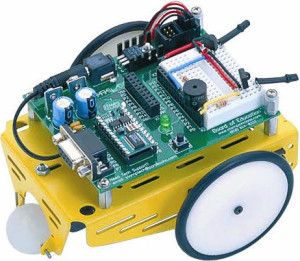
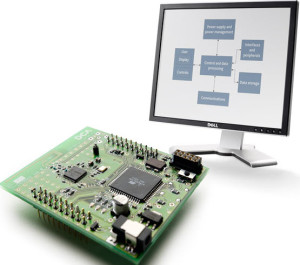
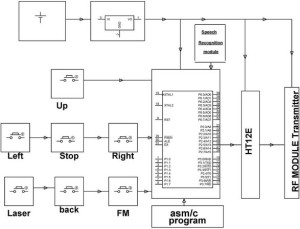
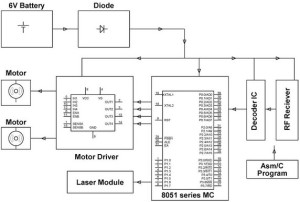
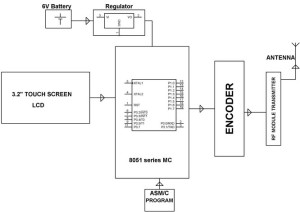
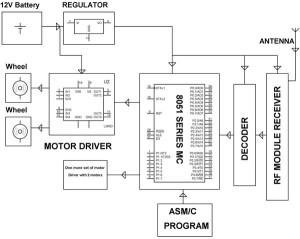
No comments:
Post a Comment